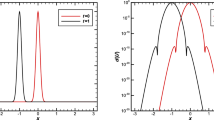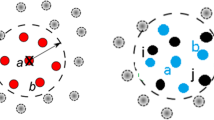Abstract
The application of large eddy simulation (LES) to turbulent reacting flow calculations is faced with several closure problems. Suitable parametrizations for filtered reaction rates for instance are hardly available in general. A way to overcome these problems is investigated here. This is done by extending LES equations for filtered velocities and scalars (mass fractions of species and temperature) to equations that involve subgrid scale (SGS) fluctuations. Such equations are called filter density function (FDF) methods because they determine the FDF, which is essentially the probability density function of SGS variables. The FDF model considered involves only three parameters: C 0 that controls the generation of velocity fluctuations and two parameters which determine the relaxation of velocity and scalar fluctuations. The consideration of this model may be seen as the analysis of a limiting case: the implications of the most simple equations for the dynamics of SGS fluctuations are investigated in this way. These equations were proved recently by various simulations. Here, the FDF model is used analytically to improve simpler methods. Existing models for the SGS stress tensor in velocity LES equations and the diffusion coefficient in scalar FDF equations are generalized in this way. The advantages of these models compared to existing ones are pointed out. These investigations provide further evidence for the suitability of the FDF model considered and they provide its parameters. A theoretical value C 0 = 19/12 is derived, which agrees very well with the results of direct numerical simulation. This estimate implies the same value for the universal Kolmogorov constant of the energy spectrum, which is consistent with the results of many measurements. The other two model parameters can be obtained then by dynamic procedures. Therefore, the closure problems of LES equations are overcome in this way such that adjustable parameters are not involved.
Similar content being viewed by others
References
Clark, R.A., Ferziger, J.H. and Reynolds, W.C., Evaluation of subgrid-scale models using an accurately simulated turbulent flow. J. Fluid Mech. 91 (1979) 1–16.
Colucci, P.J., Jaberi, F.A., Givi, P. and Pope, S.B., Filtered density function for large eddy simulations of turbulent reactive flows. Phys. Fluids 10 (1998) 499–515.
Du, S., Sawford, B.L., Wilson, J.D. and Wilson, D.J., Estimation of the Kolmogorov constant (C 0) for the Lagrangian structure function, using a second-order Lagrangian model of grid turbulence. Phys. Fluids 7 (1995) 3083–3090.
Forkel, H. and Janicka, J., Large-eddy simulation of a turbulent hydrogen diffusion flame. Flow, Turb. Combust. 65 (2000) 163–175.
Gao, F. and O'Brien, E.E., A large-eddy simulation scheme for turbulent reacting flows. Phys. Fluids A5 (1993) 1282–1284.
Gardiner, C.W., Handbook of Statistical Methods. Springer-Verlag, Berlin (1983).
Gatski, T.B. and Speziale, C.G., On explicit algebraic stress models for complex turbulent flows. J. Fluid Mech. 254 (1993) 59–78.
Gicquel, L.Y.M., Givi, P., Jaberi, F.A. and Pope, S.B., Velocity filtered density function for large eddy simulation of turbulent flows. Phys. Fluids 14 (2002) 1196–1213.
Givi, P., Model-free simulations of turbulent reactive flows. Prog. Energy Combust. Sci. 15 (1989) 1–107.
Heinz, S., Nonlinear Lagrangian equations for turbulent motion and buoyancy in inhomogeneous flows. Phys. Fluids 9 (1997) 703–716.
Heinz, S., Time scales of stratified turbulent flows and relations between second-order closure parameters and flow numbers. Phys. Fluids 10 (1998) 958–973.
Heinz, S. and Roekaerts, D., Reynolds number effects on mixing and reaction in a turbulent pipe flow. Chem. Engrg. Sci. 56 (2001) 3197–3210.
Heinz, S., On Fokker-Planck equations for turbulent reacting flows. Part 1. Probability density function for Reynolds-averaged Navier-Stokes equations. Flow, Turb. Combust. 70 (2003) 115–152.
Heinz, S., Statistical Mechanics of Turbulent Flows. Springer-Verlag, Berlin (2003).
Jaberi, F.A., Colucci, P.J., James, S., Givi, P. and Pope, S.B., Filtered mass density function for large-eddy simulation of turbulent reacting flows. J. Fluid Mech. 401 (1999) 85–121.
Kaltenbach, H.-J., Gerz, T. and Schumann, U., Large-eddy simulation of homogeneous turbulence and diffusion in stably stratified flows. J. Fluid Mech. 280 (1994) 1–40.
Kosović, B., Subgrid-scale modeling for the large-eddy simulation of high-Reynolds number boundary layers. J. Fluid Mech. 336 (1997) 151–182.
Leonard, A., Large-eddy simulation of chaotic convection and beyond. In: 35th AIAA Aerospace Sciences Meeting and Exhibit, AIAA 97–0204, Reno, NV (1997) pp. 1–8.
Lilly, D.K., The representation of small-scale turbulence in numerical simulation of experiments. In: Goldstine, H.H. (ed.), Proceedings of the IBM Scientific Computing Symposium on Environmental Sciences, Yorktown Heights, NY (1967) pp. 195–210.
Liu, S., Menevau, C. and Katz, J., On the properties of similarity subgrid-scale models as deduced from measurements in a turbulent jet. J. Fluid Mech. 275 (1994) 83–119.
Lumley, J.L., Computational modeling of turbulent flows. Adv. Appl. Mech. 18 (1978) 123–175.
Madnia, C.K. and Givi, P., Direct numerical simulation and large eddy simulation of reacting homogeneous turbulence. In: Galperin, B. and Orszag, S.A. (eds.), Large Eddy Simulations of Complex Engineering and Geophysical Flows. Cambridge University Press, Cambridge (1993) pp. 315–346.
Menevau, C. and Katz, J., Scale-invariance and turbulence models for large-eddy simulation. Annu. Rev. Fluid Mech. 32 (2000) 1–32.
Muradoglu, M., Jenny, P., Pope, S.B. and Caughey, D.A. A consistent hybrid finitevolume/ particle method for the PDF equations of turbulent reactive flows. J. Comput. Phys. 154 (1999) 342–371.
Nooren, P.A., Wouters, H.A., Peeters, T.W.J. and Roekaerts, D., Monte Carlo PDF modeling of a turbulent natural-gas diffusion flame. Combust. Theory Modeling 1 (1997) 79–96.
Overholt, M.R. and Pope, S.B., Direct numerical simulation of a passive scalar with imposed mean gradient in isotropic turbulence. Phys. Fluids 8 (1996) 3128–3148.
Pierce, C. and Moin, P., A dynamic model for subgrid-scale variance and dissipation rate of a conserved scalar. Phys. Fluids 10 (1998) 3041–3044.
Piomelli, U., Cabot, W.H., Moin, P. and Lee, S., Subgrid-scale backscatter in turbulent and transitional flows. Phys. Fluids A3 (1991) 1766–1771.
Piomelli, U., Large-eddy simulation: Achievements and challenges. Prog. Aerosp. Sci. 35 (1999) 335–362.
Pope, S.B., A more general effective viscosity hypothesis. J. Fluid Mech. 72 (1975) 331–340.
Pope, S.B., Computations of turbulent combustions: Progress and challenges. In: 23rd Symposium (International) on Combustion, The Combustion Institute, Pittsburgh, PA (1990) pp. 591–612.
Pope, S.B., Lagrangian PDF methods for turbulent flows. Annu. Rev. Fluid Mech. 26 (1994) 23–63.
Pope, S.B., Turbulent Flows. Cambridge University Press, Cambridge (2000).
Réveillon, J. and Vervisch, L., Subgrid scale turbulent micromixing: Dynamic approach. AIAA J. 36 (1998) 336–341.
Risken, H., The Fokker-Planck Equation. Springer-Verlag, Berlin (1984).
Rogers, M.M., Mansour, N.N. and Reynolds, W.C., An algebraic model for the turbulent flux of a passive scalar. J. Fluid Mech. 203 (1989) 77–101.
Sagaut, P., Large Eddy Simulation for Incompressible Flows. Springer-Verlag, New York (2001).
Sawford, B.L., Reynolds number effects in Lagrangian stochastic models of turbulent dispersion. Phys. Fluids A3 (1991) 1577–1586.
Sawford, B.L. and Yeung, P.K., Lagrangian statistics in uniform shear flow: Direct numerical simulation and Lagrangian stochastic models. Phys. Fluids 13 (2001) 2627–2634.
Sreenivasan, K.R., On the universality of the Kolmogorov constant. Phys. Fluids 7 (1995) 2778–2784.
Vreman, B., Geurts, B. and Kuerten, H., Realizability conditions for the turbulent stress tensor in large-eddy simulation. J. Fluid Mech. 278 (1994) 351–362.
Wall, C., Boersma, B.J. and Moin, P., An evaluation of the assumed beta probability density function subgrid-scale model for large eddy simulation of nonpremixed, turbulent combustion with heat realize. Phys. Fluids 12 (2000) 2522–2529.
Winckelmans, G.S., Wray, A.A. and Vasilyev, O.V., Testing of a new mixed model for LES: The Leonard model supplemented by a dynamic Smagorinsky term. In: Proceedings of Summer Program, Center for Turbulence Research, Stanford University and NASA Ames (1998) pp. 367–388.
Wouters, H.A., Nooren, P.A., Peeters, T.W.J. and Roekaerts, D., Simulation of a bluff-body stabilized diffusion flame using second-moment closure and Monte Carlo methods. In: Proceedings Twenty-Sixth Symposium (International) on Combustion. The Combustion Institute, Pittsburgh, PA (1996) pp. 177–185.
Zhou, X.Y. and Pereira, J.C.F., Large eddy simulation (2D) of a reacting plane mixing layer using filtered density function closure. Flow, Turb. Combust. 64 (2000) 279–300.
Author information
Authors and Affiliations
Rights and permissions
About this article
Cite this article
Heinz, S. On Fokker–Planck Equations for Turbulent Reacting Flows. Part 2. Filter Density Function for Large Eddy Simulation. Flow, Turbulence and Combustion 70, 153–181 (2003). https://doi.org/10.1023/B:APPL.0000004934.22265.74
Issue Date:
DOI: https://doi.org/10.1023/B:APPL.0000004934.22265.74




